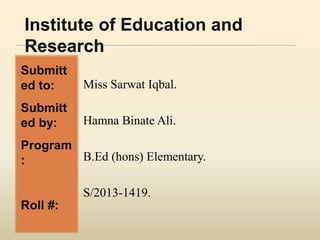
Solving discipline and classroom management
- 1. Institute of Education and Research Submitt ed to: Submitt ed by: Program : Roll #: Miss Sarwat Iqbal. Hamna Binate Ali. B.Ed (hons) Elementary. S/2013-1419.
- 2. TOPIC: Solving Discipline And Classroom Management Problems (Methods and Models For Today’s Teachers)
- 3. Content Rogerian Theory. Major Postulates. Steps for Solving Behavioral Issues. Self Concept. Role of a Teacher. Rogerian Theraphy. Teacher Effectiveness Training & Central Behaviors. Teacher Response “I” message. Modeling.
- 4. Rogerian Theory Freudian Therapy tells that each child has innate inner aggressive drives. Rogerian theory by Carl Rogers, tells that each child is Rational & capable. Rogers follow H. Maslow’s belief that each child is born “prior to good and evil”.
- 5. Major Postulates: It is impossible for one person to take decision for another person. Each child has capacity for being rational and capable and Child is always use what is good for him/her. Any two people in a given situation will experience and act differently. Each person deals and interpret a certain situation according to its prior encounters, goals, expectation & attitudes
- 6. Life is a process of changing situations and challenges/problems. An individual act by taking multitude decisions and according to his past experiences. By expressing ones feelings & concerns an individual can come to most appropriate rational decision.
- 7. Steps for solving behavioral issues Teacher’s empathic, non-judgmental position Encouraging the student to talk out. Problem solving. Giving choice paths to the student: One in which teacher wins e.g. punishing etc. One in which student wins e.g. completely ignoring student’s behavior. No-lose problem solving i.e. using six steps of problem solving.
- 8. Self concept: Make student develop idea of self concept. Self concept defined as set of ideas and feelings that one has about himself. A person is realized in meeting his own life’s challenges and in solving his own problems. If teacher instead of Rogerian therapy, lecture the student or punish him, it might give opposite results.
- 9. Role of a Teacher Teacher’s role should be: • Supportive, Non-critical facilitator. • Develop rational abilities of the student to identify and solve their own problems. • Teacher should acknowledge the student. • Teacher should be influencing.
- 10. Rogerian Therapy According to the Rogerian therapy, each child is “exquisitely rational” and Problems occur when that rationality is stifled when teacher set about to order, direct or force student to behave according to teacher’s will.
- 11. Teacher Effectiveness Training T. Gordon used Rogerian therapy in T.E.T Teacher behavioral continuum (TBC) is used as organizer in comparing central behaviors These central behaviors are: Silent looking Naming statements Questions
- 12. Directive statements Reinforcements Modeling Physical intervention & isolation Looking: •Teacher must “ exchange of ideas between Students. •The 1st step in TBC, is for the teacher to simply look at the misbehaving student.
- 13. Questioning (skipping naming statements temporarily): • If student is having problem in talking or stop talking in mid & cant start talk again then approach Gordon called “Door openers or Reopeners” is used. • It involves asking questions like: I’m interested, would you like to talk more about it? Or ,would you like to go on? etc.
- 14. Naming statements: In T.E.T most important use of language by teacher is “Active listening”. It is to use silence to acknowledge the responses or to use door openers. In naming statements or nondirective statements teacher actively communicate with student that he/she is being understood. Teacher can summarize or mirror student’s feelings or problems in order to show that he understands them.
- 15. Active listening :to increase communication between child and teacher in which child s encouraged to talk out and teacher masks student’s feelings. Child always use unique coding to hide his feelings e.g. Child language “ John is mean!” Teacher’s active listening “ John has made you angry!” Child Teacher Encoding Active listening
- 16. Feeling words: •Feelings are hard to be expressed in words. •Student commonly use different words to express feelings. Negative Feelings Angry Sad Confused Scared Hate Unhappy Mad worried frightened unfair Positive Feelings Appreciate Happy Enjoy Love Better joyful Cheerful Like Great wonderful
- 17. Types of teacher’s reponses: Critical listening (silence) Acknowledgments (gestures) Door openers or Reopeners Active listening “I” message Method III problem solving
- 18. “I” message: It is the statement by teacher that gives full description of teacher’s feelings & also students behavior along with its effects. In problem solving a teacher gives an “I” message to tell the student of its situation and then, Usually teacher provides student with “door opener”.
- 19. Modeling: Six steps of modeling: Step I. Defining problem: using active listening and “I” message teachers help to find out the problem. Step II. Generating possible solutions It is to brainstorm many different solutions without evaluating.
- 20. Step 3&4. Evaluating & deciding on solution(s) After making a list of all possible solutions, teacher and student(s) go through all of them to see which is best suited. Step 5 & 6. Implementing & Evaluating solution(s) In final step it must be agreed by all that who will do what and when they will begin etc Set a time to meet again to reevaluate the results.
- 21. THANK YOU
